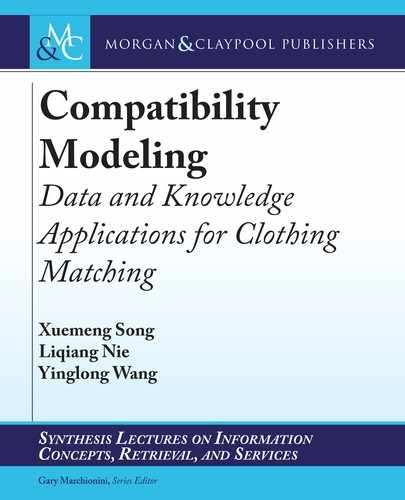
1
C H A P T E R 1
Introduction
1.1 BACKGROUND
According to the FashionUnited.com,
1
the global fashion and apparel industry has been valued
at three trillion dollars, making up 2% of the world’s gross domestic product, demonstrating the
blossoming of the fashion market and people’s great demand for clothing. In fact, apart from
the physiological needs, people also have reasons of self esteem for clothes, as dressing properly
is seen as an important part of daily life. As each outfit usually involves multiple complementary
items (e.g., tops, bottoms, and shoes), the key to a proper outfit usually lies in harmonious
clothing matching. Nevertheless, the tremendous amount of fashion items available tends to
overwhelm people, making it rather difficult for them to compose suitable outfits, especially
for those who lack a good fashion aesthetic. It is thus highly desirable to devise an automatic
clothing matching scheme to help people find a suitable match for a given item in order to make
a harmonious outfit.
Meanwhile, recent years have witnessed the proliferation of various online fashion-
oriented communities, such as Polyvore,
2
IQON,
3
and Chictopia,
4
where fashion experts can
share their fashion tips by showcasing their outfit compositions to the public. Figure 1.1 shows
several composition examples on Polyvore. As a matter of fact, for better illustration, clothing
items on fashion-oriented communities are usually associated with not only visual images with
clean backgrounds but also rich contextual metadata, such as titles and categories. Accordingly,
the tremendous volume of outfit compositions with rich metadata naturally makes the online
fashion-oriented community a wonderful venue to investigate the code in clothing matching. In
addition to these fashion-oriented communities, popular e-commerce websites, like Amazon
5
and eBay
6
that enable users to review their purchased products with detailed size descriptions,
also provide significant cues for clothing matching. ese valuable reviews can not only tell users’
preferences on fashion items but also their body shapes, which would facilitate the personalized
clothing matching.
1
https://fashionunited.com/global-fashion-industry-statistics/
2
Polyvore has been acquired by the global fashion platform Ssense in 2018. Previously, fashion lovers could share their
outfits compositions to the public on Polyvore.
3
http://www.iqon.jp/
4
http://www.chictopia.com/
5
https://www.amazon.com/
6
https://www.ebay.com/

2 1. INTRODUCTION
(a) Composition 1. (b) Composition 2. (c) Composition 3.
Figure 1.1: Example outfit compositions on Polyvore.
1.2 CHALLENGES
In this work, we focus on the essential problem for clothing matching: compatibility modeling,
which aims to assess the compatibility score for a given set of (equal or more than two) fashion
items, e.g., a T-shirt and jeans. As the compatibility modeling involves not only a large number
of feature variables but also complicated factors such as the domain knowledge and user factor,
it suffers from the following challenges.
First is the comprehensive modeling. Existing studies have mainly focused on measuring
the compatibility between fashion items based on their visual images but ignored the contextual
information, such as the item description title and categories, which can also convey the key fea-
tures of items and contribute to the compatibility modeling. Moreover, as different modalities
characterize the same fashion item, they should preserve certain semantic correlations. Accord-
ingly, how to model the coherent correlation between the visual and contextual modalities of
the same fashion item, and seamlessly fuse different modality data to boost the performance, is
a major challenge we are facing.
Second is the knowledge incorporation. In fact, as an essential aspect of people’s daily life,
much valuable knowledge (e.g., the clothing matching rules) in the fashion domain has been
accumulated, which may guide the pure data-driven compatibility modeling scheme to learn
better. Nevertheless, the human knowledge in the fashion domain is usually implicitly con-
veyed by the large amount of outfits composed by fashion experts, and tends to be unstructured
and fuzzy, making it intractable to directly embed the knowledge into the data-driven learning
scheme. erefore, how to properly encode the domain knowledge, integrate it into the pure
data-driven learning scheme, and hence enable the model to learn from both the specific data
and the knowledge rules pose another challenge for us.
..................Content has been hidden....................
You can't read the all page of ebook, please click here login for view all page.
